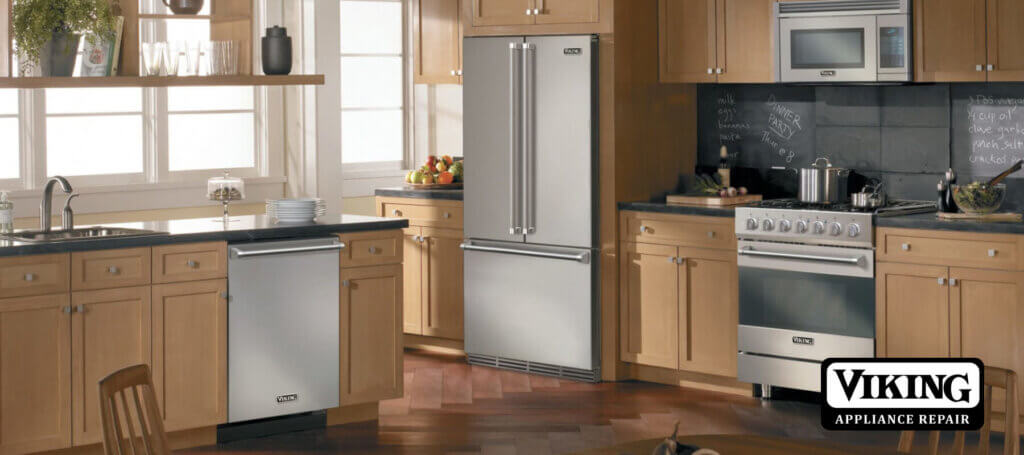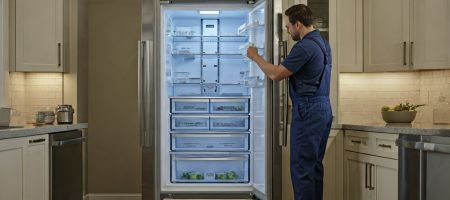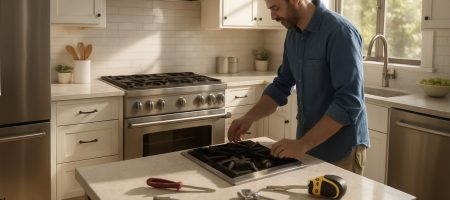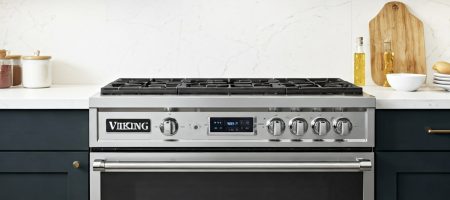Typical Reasons Why Your Viking Refrigerator Is Not Cooling
You open your Viking refrigerator one hot morning, wanting to drink cold soda or juice, but it’s not cooling. That is an awful circumstance. So you probably think you need a certified Viking appliance repair immediately, but before that, you must know what the causes of this problem are. Here are some probable causes for your Viking refrigerator, not cooling:
- Frosted evaporator coil: Too much frost on the evaporating coils might cause poor cooling. Frost forms on the coils and fan over time.
- Faulty evaporator fan: Failure of the evaporator fan transfers cooled air from the freezer to various compartments within a refrigerator. Cold air cannot circulate within the food part if the evaporator fan stops working. As a result, although the freezer stays cold, the food compartment does not.
- Out-of-order Defrost System – In every frost-free refrigerator, a defrost system manages the cooling and defrost cycles. A defrost timer and a defrost heater are two components of the defrost system. As a result, if any of the two fails, the refrigerator does not know when to chill and defrost.
- A Malfunctioning Compressor – The compressor is the heart of the refrigeration cycle. When it fails to function correctly, the entire cooling process is halted. Air circulates across the cooling coils, keeping the refrigerator cold. When the compressor fails, the refrigeration cycle does not even begin.
- Insufficient refrigerant level: If the compressor is the heart of the cooling cycle, the refrigerant is the blood. The cooling within the refrigerator is also affected by refrigerant leakage or under-limit refrigerant.
- Dirt-insulated condenser coils: When high-pressure hot refrigerant condenses in the condenser, a significant amount of heat is lost. However, heat does not flow correctly out of the coils when the condenser coil is unclean and clogged with debris. This heat remains within the refrigerator, reducing cooling.
- Faulty thermistor: A thermistor is a sensor that regulates the air temperature of the refrigerator as well as the start and stop of the cooling cycle. If it fails, the refrigerator either does not cool or constantly cools.
Now you know what causes you need to search for a Viking appliance repair near me and have an exceptional Viking refrigerator repair.
The Process On How Do You Clean The Coils On A Viking Built-In Refrigerator
Cleaning your Viking appliances, particularly your Viking refrigerator, is an excellent method to lower your energy cost and improve the life of your refrigerator. Refrigerator coils, also known as condenser coils, are the black coils found on the back or bottom of your refrigerator. If there is a lot of dirt or dust on the coils, it takes more energy to chill your food and may ultimately break down.
- Unplug your refrigerator from the wall. Pull and remove the power cord after turning off the power switch. Don’t worry about your food becoming heated during the cleaning procedure; the fridge will keep its low temps while you clean the coils.
- Pull your refrigerator away from the wall to have access to the coils at the rear. The coils in older refrigerators are usually located on the rear of the fridge. Gently move the fridge forward at least 1 meter (39 in) to make room for cleaning the coils.
- If the coils aren’t in the rear, unclamp the bottom panel of the fridge. Many new refrigerators have coils buried behind the bottom panel at the front. Remove this panel by unsnapping and placing it somewhere secure while you clean the coils.
- Use a soft-bristled brush, and remove the dirt. Grime accumulates on the refrigerator coils over time. Using your brush, agitate the coils to remove as much debris and dust as possible. Scrape the dirt clumps away from the coils from above, below, and between them.
- Using a vacuum, remove any leftover dust. Put a narrow nozzle on the end of your vacuum cleaner hose if feasible. It makes sucking up dust from between the coils simpler. Move the nozzle over the coils to let the suction pick up all the gunk.
- Repeat the scraping and sucking until all of the dirt has been removed. Vacuuming might sometimes uncover extra dirt on or around the coils. Remove the remaining dust and grime with the coil brush before sucking it up with your vacuum.
- Reconnect power and reposition the refrigerator. Push your fridge back into its original position if required. Plug your fridge back in and switch on the electricity after it has returned to its original position.
Viking Appliance Repair Pros can not only fix your Viking appliance services but also advise you on how to maintain its functioning effectively. Don’t hesitate to contact Viking Appliance Repair Pros if you have any queries or issues!
Our services are not limited to only one area; you can also contact appliance repair pros Seattle, appliance repair pros Denver, and appliance repair pros Burbank. We offer fast, accurate, and effective processes to repair your refrigerator and other Viking appliances. Call Viking Appliance Repair Pros for any issues your Viking refrigerator has!











